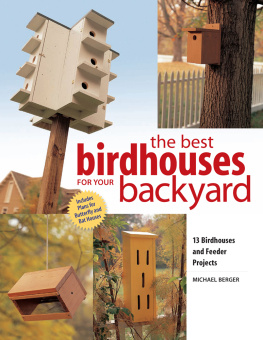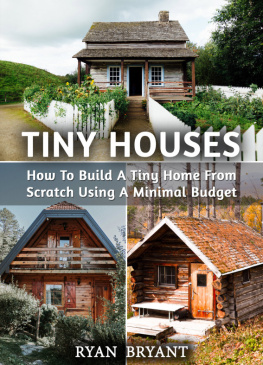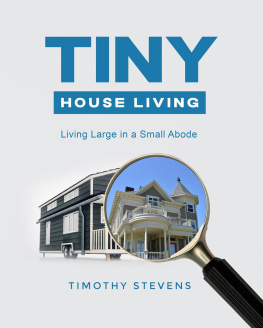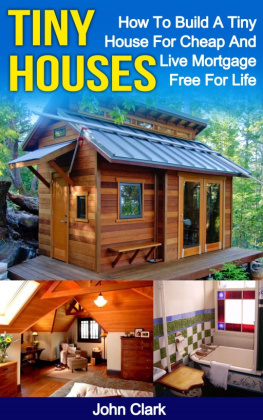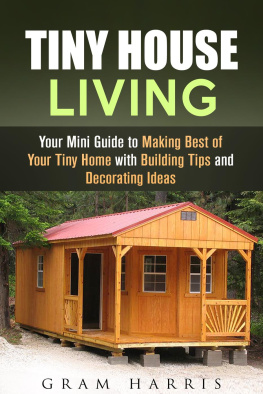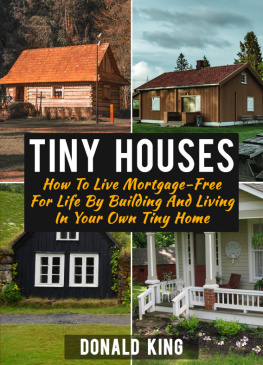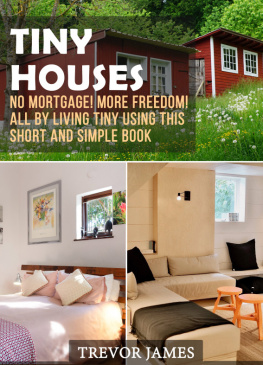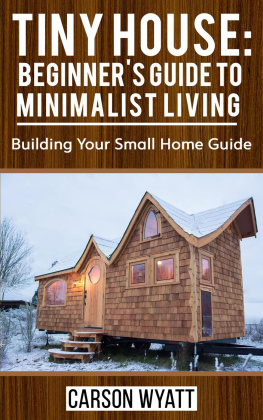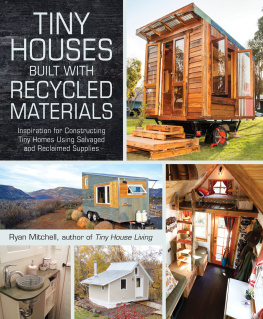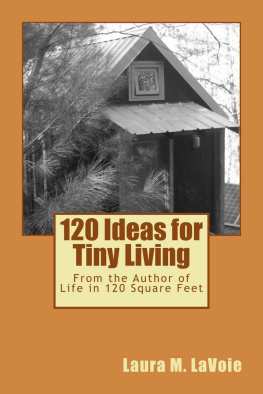Tiny Homes
Beginners Guide to Smart Ideas of Tiny Homes in 400 Square Feet or Less
Copyright 2020 - All rights reserved.
The content contained within this book may not be reproduced, duplicated, or transmitted without direct written permission from the author or the publisher.
Under no circumstances will any blame or legal responsibility be held against the publisher, or author, for any damages, reparation, or monetary loss due to the information contained within this book, either directly or indirectly.
Legal Notice:
This book is copyright protected. It is only for personal use. You cannot amend, distribute, sell, use, quote or paraphrase any part, or the content within this book, without the consent of the author or publisher.
Disclaimer Notice:
Please note the information contained within this document is for educational and entertainment purposes only. All effort has been executed to present accurate, up to date, reliable, complete information. No warranties of any kind are declared or implied. Readers acknowledge that the author is not engaging in the rendering of legal, financial, medical, or professional advice. The content within this book has been derived from various sources. Please consult a licensed professional before attempting any techniques outlined in this book.
By reading this document, the reader agrees that under no circumstances is the author responsible for any losses, direct or indirect, that are incurred as a result of the use of the information contained within this document, including, but not limited to, errors, omissions, or inaccuracies.
Table of Contents
Introduction
Tiny homes aren't a new concept. For a long time, people have been sheltering in tiny structures like yurts. For example, a prehistoric Greek historian by the name Herodotus from central Asia presented the first yurts around 600 BC to AD 300. Also, in the early days, the nomadic communities sheltered in felt-covered tents in various environments such as deserts, hills, tropics, and mountains.
In the modern-day, people turn to tiny homes for different reasons other than survival as it was in the past. For example, the hectic demands of present-day life have led some people to look for ways of escaping to finding solace in a different way of life. Simply put, in times of financial and social hardships, most individuals will channel their energies to what matters most and overcome the pressure that comes with mortgages and rent. To others, life is not just about what you own but appreciating who you are. Tiny living encompasses living life to the fullest and finding it easy to live happily in a space that's 400 square feet or less. This is the main drive behind the tiny home movement.
Today, tiny homes are not a trend that has been made popular by television shows, blogs, and opinion editorials that will fade in a few coming years. It's a movement that has come about due to an ever-growing need for individuals to downsize and simplify how they live but, at the same time, maintain optimal style and function. Actually, a tiny home offers the owner a chance to live big through considerable cost savings and mobility. That's why these homes are cropping up in various parts of the United States and other parts of the globe. The media and government, non-governmental agencies, are trying hard to scrutinize the main idea that is making such homes a darling to many people.
The rising popularity of tiny homes has motivated the debate on the advantages of downsizing and living on a smaller footprint. What started as an ' undercover' DIY movement has become a full-scale trend, stuffed with dedicated websites, professional builders, architects, television shows, municipalities, print publications, and learning institutions committed to advancing the surging interest in living a mortgage-free lifestyle.
The rising costs of mortgages, ever-increasing house prices, diminishing space for new projects, unreliable landlords are some of the motivating factors driving the tiny homes concept. The housing shortage has become a genuine social problem that requires attention from governments, homeowners, and other stakeholders.
If you're considering owning a home without breaking the bank, a tiny house could be the answer you're looking for. Not only are those properties an excellent way of saving on housing costs but also an affordable way of building and maintaining a home. If you are considering a building or purchasing such a home, this guide will equip you with all the detail you need to look into to make your dream a success.
Chapter 1: Tiny Homes Basics
We are living in a fast-changing world, economic, social, and environmental dynamics drive us to reconsider how we live on this planet. Visualize a life where you aren't paying any mortgage, rent, or utility bills. Imagine a home where you can generate your own electricity and collect its water. How will your life be if you're debt-free? that's what a tiny home presents.
The urban population is rising at an alarming rate globally; in this regard, there's a need to look for viable solutions to this problem. The various types of tiny homes could be the solution we have been waiting for. For example, the unused shipping containers lying all over could be converted to completely functional homes and become the solution for those desiring to own homes affordably.
The tiny home could be your main home or a distinct structure on the property that already has another house. It's essential to note that cottages, recreational vehicles, campers, and related structures that are used seasonally can't be categorized as tiny homes.
Difference between a Small and Tiny Home
Although there's no set definition on what a tiny home is, there's a general agreement that they are between 100 to 400 square feet. Some may be up to 500 feet. Most tiny houses are mobile. The main benefit of such houses is the freedom to move them whenever you desire. This doesn't mean you have to build the house on a trailer or frame bearing wheels. Some tiny homes are permanent.
Most individuals associate tiny homes with the mobile houses they see on the television. If you want to build a tiny mobile home, you can purchase the respective house plans or buy an already built portable house. Tiny homes seem to be a trend that may never fade. Since 2007, their popularity has been increasing steadily. Living in tiny houses isn't for everyone; it's for those who are ready to sacrifice the pleasure of living in big and adopting a real minimalist lifestyle.
Small homes, on the other hand, refer to houses ranging from 400 square feet to 1,000 square feet. Some may be as large as 2000 to 3000 square feet. The small homes are for those who aren't ready for the tiny homes, yet they want to adopt a minimalist lifestyle. The size of the small house will depend on your objectives and the amount of space you require. It may also vary depending on the average size of small homes in your locality.
The definition of small and tiny homes isn't constant; as years go by, the size description may change. For example, a small home may be between 500 to 3000 square feet in a few years to come. Typically, small houses are permanent and not mobile as the case with most tiny homes. If you go to a small home, you may not have the pleasure of moving with your home all over the world. Anyway, they are an excellent option for those desiring to live in smaller spacesmostly millennialsbut includes the amenities in ordinary houses. Generally, most small homes have two bedrooms.





